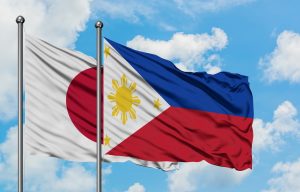On November 3, Japanese Prime Minister Kishida Fumio and Philippine President Ferdinand Marcos Jr. agreed to expand bilateral defense cooperation in order to better respond to common security challenges, with China’s growing military activities in the South and East China Seas in mind.
Military and security ties between Japan and the Philippines have been growing rapidly, with major Japanese media such as Nikkei and Asahi Shimbun saying that the two countries aim to upgrade their relationship to a “quasi-alliance.”
After a red-carpet welcome at the Malacanang Palace in Manila, the two leaders held talks on bolstering overall relations, primarily defense ties. They agreed to start negotiations for a defense pact called the Reciprocal Access Agreement (RAA), aiming to facilitate the presence of visiting forces and conduct joint military training activities.
If formally signed, it would be Japan’s first RAA with a member of the Association of Southeast Asian Nations and Japan’s third overall. Similar agreements with Australia and the United Kingdom took effect earlier this year. Japan has long undertaken defense cooperation with the United States under the Status of Forces Agreement signed in 1960.
The RAA would enable the Japan Self-Defense Forces (JSDF) and the Armed Forces of the Philippines (AFP) to train and operate in each other’s territories.
Joint activities such as exercises, air-to-air refueling, and patrols would be facilitated through the pact. Procedures for obtaining visas to enter the other country and bringing in weapons and ammunition will be simplified when they conduct joint exercises.
In February, the two leaders already signed the Terms of Reference (TOR) concerning Humanitarian Assistance and Disaster Relief (HADR) activities of the JSDF in the Philippines. That pact also aims to simplify the procedures for JSDF troops visiting the Philippines, as one of the efforts to enhance and facilitate cooperation on HADR. Now cooperation between the two countries is about to extend to the military field.
On November 3, Kishida also agreed to provide the Philippines with Japan’s coastal surveillance radar system and other equipment under the new Official Security Assistance (OSA) framework, which Tokyo launched in April to provide defense equipment and other supplies to like-minded countries to enhance security cooperation. The Japanese Foreign Ministry has already chosen the Philippines, Malaysia, Bangladesh, and Fiji as OSA recipients for fiscal year 2023.
In addition, on November 2, the Japanese Defense Ministry and Mitsubishi Electric (MELCO) announced that the company has delivered the first unit of an air-surveillance radar system to the Philippine Air Force in October.
In August 2020, MELCO signed a contract worth about $100 million with the Philippine Department of Defense to export three fixed air-surveillance radar and one mobile radar systems. This is the first time a Japanese company has transferred finished defense equipment to a foreign government since the Japanese government established the so-called Three Principles on Transfer of Defense Equipment and Technology in April 2014.
The latest agreements between Kishida and Marcos came as Japan plans to hold a special summit in Tokyo in December to mark 50 years of friendly and cooperative relations between Japan and the Association of Southeast Asian Nations (ASEAN). This year marks a half century since official ties were established between Japan and ASEAN in 1973. Kishida is visiting the Philippines and Malaysia for three days starting from November 3 to ask for help in staging the successful special summit.
The agreement also came amid escalating tension between Beijing and Manila over disputed maritime features in the South China Sea. Tension also ran high after a Chinese fighter jet came within 10 feet, about 3 meters, of a U.S. Air Force B-52 bomber flying over the South China Sea on October 24.
Malaysia, where Kishida will visit after the Philippines, also has territorial disputes with China in the South China Sea.
While U.S. President Joe Biden skipped the latest ASEAN summit and coinciding East Asia Summit held in Jakarta, Indonesia, Kishida is intentionally striving to visit ASEAN countries at calculated times, not only to deepen bilateral relations but also to explain the importance of the Free and Open Indo-Pacific (FOIP) initiative and the “international order based on the rule of law.”
Kishida visited Cambodia, which was the ASEAN chair in 2022, within one month of Russia’s invasion of Ukraine. He also traveled to Indonesia, which was the G-20 chair, and Thailand, which was the APEC chair last year. He also went to Vietnam in May 2022 to exchange views. With Japan as the only Asian member of the G-7, Kishida’s trips played an important role in sharing the G-7’s perspective on the Russia-Ukraine War.
On November 4, Kishida will give a speech to the Philippine Congress outlining the basic policy of Japan’s diplomacy in Southeast Asia. It will be the first speech to the Philippine legislature by a Japanese prime minister.

































